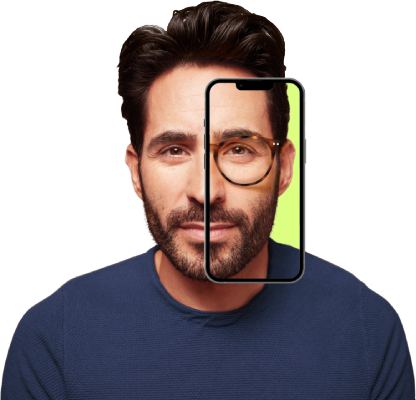
With our virtual try-on tool, finding your perfect pair is as easy as looking into your camera.
Everything you need to know to take care of your eyes — for life.
The millimeters between each pupil matter when it comes to getting the right pair of prescription eyeglasses.

Have you ever glanced at your eyeglasses prescription and seen the letters “PD”? Or have you been asked to type in your “PD” when ordering eyeglasses online? What do those letters stand for, anyway?
When you get measured for eyeglasses, your optician takes down a lot of important numbers. One of them? Your pupillary distance. Called PD for short, this number plays a big role in how well you see through your eyeglasses.
Here’s what you need to know about this important measurement, including what it means and why your eye doctor needs to know it.
The eye care specialists at America’s Best can help you find lenses that are just right for you! Learn more here.
“Pupillary distance is the distance between the centers of your pupils,” says Natalie Martin, a Tampa, Florida–based optician and regional learning specialist for National Vision, Inc. The pupil is the dark round opening in the center of your eye that controls how much light enters the eye. (It’s the part of the eye that gets bigger in the dark and smaller in the light.)
Pupillary distance differs for everyone. It’s measured in millimeters (mm), and adults have PDs that typically range from 50 mm to 70 mm.
If your PD is incorrect, you may find that things seem “off” when you look through your glasses. “You can get a bit of eyestrain, or things might not seem quite as clear,” says Martin. That’s because a correct PD ensures that you’re looking through the right part of the lens.
There are two types of pupillary distance that your optician can measure. The one they choose depends on the type of lenses you’re getting: single-vision or multifocal lenses.
Binocular PD
People who wear single-vision lenses have one prescription across their entire lens. If this is what you wear, your optician will measure the distance between the pupils of each eye. The resulting number is your PD.
Monocular PD
If you wear progressive lenses, you have multiple prescriptions in one lens. In this case, your PD will be taken from the center of your pupil through the center of the bridge of your nose. This measurement is taken separately for each eye, and your PD will be two numbers.
PD is an important factor for all lenses. But people who wear progressive lenses may notice more easily if their PD measurement is slightly off.
“Our eyes are not symmetrical, and we want to make sure that the pupillary distance is split properly for each eye in a progressive lens,” says Martin. Meaning, each of your two pupils may be at a different distance from your nose. That’s why taking two measurements is more accurate.
Progressive lenses have what are called “swim areas,” which are areas of the lens that can appear distorted or blurry. (It’s similar to what you’d see if you were to open your eyes underwater, hence the nickname.) “If your prescription is off in terms of the pupillary distance, you’ll get more of the wavy swim area,” says Martin. “Instead of being crystal clear, your vision may be blurry or hazy.”

With our virtual try-on tool, finding your perfect pair is as easy as looking into your camera.
Once you’re an adult, your PD will likely remain the same throughout your life. Nevertheless, your optician will measure your PD every time you get a new pair of eyeglasses. “We will always measure it for every pair of glasses with every order,” says Martin. PD is an important part of your prescription, so each time your prescription changes, you’ll have this number taken again.
Your America’s Best optician is the best person to measure your pupillary distance. They do this using a small handheld device called a pupilometer. It shines a light into the center of your pupils to create this measurement.
“We can use it to record different measurements for various vision needs,” says Martin.
Your optician may also use a tool called a pupillary distance ruler, which is a ruler specifically designed to measure the distance between your pupils or between your pupils and the bridge of your nose. It looks like a regular ruler but has spaces to position around your eyes.
Sometimes, the eyeglasses prescription you have in hand might not include your PD measurement. If that’s the case, you can request this information from the optician who examined you, says Martin. You’ll need this number if you’re ordering glasses online and are manually entering your prescription information.
When you order glasses online at America’s Best, there will be an option to enter one or two PD numbers, depending on what type of lenses you’re purchasing.
Need a new glasses prescription or need to know your PD? Call the America’s Best location nearest you and ask if an optician is available to measure you. Once you have all your numbers, you can get eyeglasses that are perfectly suited for your eyes and vision needs.
See our sources:
About pupils: National Cancer Institute
Pupillary distance: Cleveland Clinic